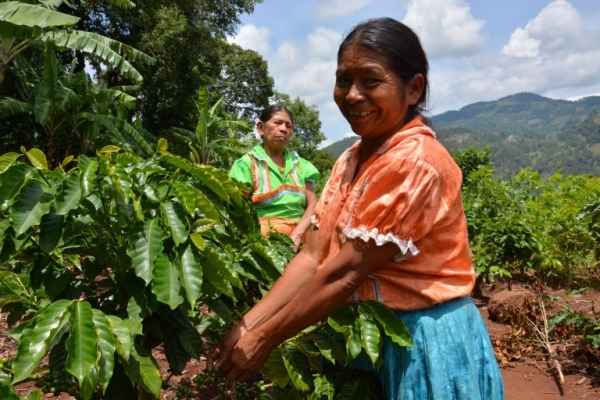Starting small, thinking big: seven ingredients that help smart agriculture thrive

Rural farmers in many parts of the world are already using ‘smart’ agricultural practices like intercropping, agroforestry and rainwater harvesting.
But what if those practices benefitted the livelihoods and landscapes of millions more?
Climate-smart agriculture, the raft of sustainable agricultural practices designed to help farmers overcome hunger, adapt to climate change, manage their natural resources and curb rising temperatures, is a hot development theme worldwide. But its success will be measured not only in local benefits, but its ability to adapt and spread as resource demands grow and global challenges intensify.

Farmers tending a pepper garden in Southeast Sulawesi as part of The Agroforestry and Forestry in Sulawesi project. Photo by Yusuf Ahmad/ICRAF
Getting to scale
Scaling up climate-smart agriculture means replicating, spreading or adapting technologies and practices that secure more food on less land and in more sustainable ways.
This is more complex than scaling up straightforward technological innovations, such as new grain varieties, because it requires much more profound change. Integrating appropriate trees into complex agricultural systems, for example, involves training farmers, developing new supply chains, modifying current farming practices and then managing trees for competition with crops.
According to the World Bank, those who live in rural areas – a staggering 70% of the world’s poor – will be most vulnerable to more variable and extreme weather. They often lack the governance, assets and technical capacity to innovate and adapt.
Scaling up climate-smart agriculture takes not only the right practices, technologies or models, but the right conditions to make it happen, which may include incentives and insurance schemes for farmers, consumer demand and of course, the political will from their governments.
Building on a series of workshops and eight of the latest climate-smart agriculture case studies from South Asia, a new World Agroforestry Centre working paper, Scaling up climate-smart agriculture: lessons learned from South Asia and pathways for success, identifies seven key ‘ingredients’ and several pathways for successfully scaling up climate-smart agriculture.
The paper aims to help policy makers and rural development practitioners strategically plan scaling up of successful climate-smart agriculture practices – whether replicating practices, technologies or models in new areas (horizontal scaling), catalyzing institutional and policy change (vertical scaling) or changing strategy (diagonal scaling).
Seven ingredients for success
Seven key elements can help planners understand the challenges and opportunities for scaling up climate-smart agriculture.
- Landscape approaches – recognizing the diverse (and often conflicting) benefits that landscapes provide, such as farming, forestry, tourism and protected areas, and working to achieve social, environmental and economic objectives together.
- Drivers and spaces – working with factors that promote (such as corporate sustainability standards or community demand for changes in technologies) and enable growth (such as financial resources and political frameworks) of climate-smart agriculture.
- Partnerships and knowledge management – building effective partnerships and working together to create and share new knowledge.
- Participatory project management – involving all partners, making strategic decisions and improving project management over time.
- Multidimensional monitoring and evaluation – measuring progress towards diverse social, economic and environmental objectives at different scales.
- Capacity development through co-learning – building local capacity by actively involving farmers in research, innovation and extension.
- Inclusiveness – maximizing the benefits of including women and other disadvantaged groups in scaling up climate-smart agriculture.

Rose Koech grows fodder trees, shrubs and grass for her dairy cattle on her farm in Kenya. Photo by Sherry Odeyo/ICRAF
Pathways for change
These seven ‘ingredients’ play important roles during all three stages of scaling up climate-smart agriculture: effectiveness, efficiency and expansion. Effectiveness means developing, testing and evaluating climate-smart agriculture practices and technologies locally; efficiency means testing them with an expanded group or in larger areas; and expansion means implementing proven climate-smart agriculture practices and technologies at scale.
Each stage involves different actors, partnerships and investments. “We wanted to guide project leaders to find their place in the scaling up process and understand what partnerships and investments they can use to take the next steps,” explained Henry Neufeldt, lead author of the paper. “With that knowledge, the paper can help map out pathways to achieve greater climate-smart agriculture adoption and impact.”
No recipe for success
Ultimately, there is no set recipe for helping climate-smart agriculture expand. The seven ingredients are not quotas to be met; rather, they provide a tool for climate-smart agriculture practitioners and policy makers to look ahead and concentrate on challenges and how to overcome them by identifying opportunities for scaling up these practises.
By using this tool, project leaders and partners can plan for transitions across the major stages of scaling up and adapt their projects strategically. For the best chance of success, climate-smart agriculture scaling should be driven by shared leadership across sectors and scientific disciplines, while all involved continue to experiment and learn.
Read the paper: Scaling up climate-smart agriculture: lessons learned from South Asia and pathways for success.
Neufeldt H, Negra C, Hancock J, Foster K, Nayak D, Singh P. 2015. Scaling up climate-smart agriculture: lessons learned from South Asia and pathways for success. ICRAF Working Paper No. 209. Nairobi, World Agroforestry Centre. DOI: http://dx.doi.org/10.5716/WP15720.PDF



Facebook comments